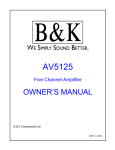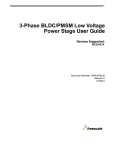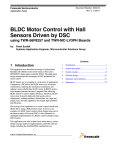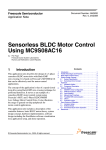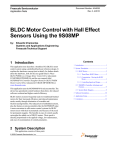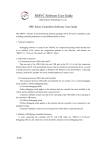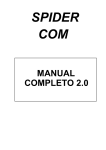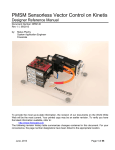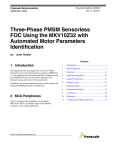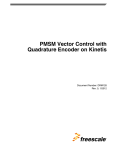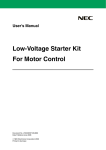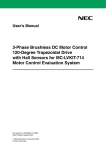Download Sensorless BLDC Motor Control Using S12G240 Based on HVAC
Transcript
Freescale Semiconductor Application Note Document Number:AN4618 Rev. 0, 10/2012 Sensorless BLDC Motor Control Using S12G240 Based on HVAC Platform by: Zhen Liu, Peng Chen, and Changhao Shi Contents 1 Introduction 1 Introduction................................................................1 This application note describes the design of a three-phase sensorless BLDC motor drive with back-EMF zero-crossing. It is based on Freescale’s MC9S12G240 MCU that can be effectively used for motor control applications. 2 S12G family features................................................1 3 BLDCM theory.........................................................2 4 System Design Concept............................................3 The concept of the application is that of a speed-closed loop drive using back-EMF zero-crossing technique for positional detection. It serves as an example of a sensorless BLDC motor control system using Freescale’s MCU and three-phase BLDC/PMSM low-voltage motor control drive. It also illustrates the usage of general on-chip peripherals for motor control applications, controller features, basic BLDC motor theory, system design concept, hardware implementation, software design including the FreeMaster software visualization tool, application setup, and demo operation. 5 Hardware...................................................................4 6 Software...................................................................10 7 Demo setup and operation.......................................13 8 References...............................................................15 2 S12G family features On-chip modules available within the S12G family include the following features: • S12 CPU core, 25 MHz bus • Up to 240 KB on-chip flash with ECC • Up to 4 KB EEPROM with ECC • Up to 11 KB on-chip SRAM • Up to one multiscalable controller area network (MSCAN) module © 2012 Freescale Semiconductor, Inc. BLDCM theory • • • • • Supporting CAN protocol 2.0 A/B Up to three serial communication interface (SCI) modules. Supporting LIN communications Precision fixed voltage reference for analog-to-digital conversion (ADC) 1 MHz internal oscillator On-chip voltage regulator for input supply and internal voltages 3 BLDCM theory The brushless DC (BLDC) motor (BLDC is a rotating electric machine with a classic three-phase stator like that of an induction motor; the rotor has surface-mounted permanent magnets. It is also referred to as an electronically-commuted motor. There are no brushes on the rotor and the commutation is performed electronically at certain rotor positions. The stator is usually made from magnetic steel sheets. A typical cross section of a BLDC Motor is shown in Figure 1. The statorphase windings are inserted in the slots (distributed winding) or they can be wound as one coil onto the magnetic pole. Because the air-gap magnetic field is produced by permanent magnets, the rotor magnetic field is constant. Figure 1. BLDC motor ontology The magnetisation of the permanent magnets and their displacement on the rotor is chosen so that the shape of back-EMF, that is, the voltage induced on the stator winding due to rotor movement, is trapezoidal. This allows the DC voltage (see Figure 2 ) with a rectangular shape to be used to create a rotational field with low-torque ripples. Sensorless BLDC Motor Control Using S12G240 Based on HVAC Platform, Rev. 0, 10/2012 2 Freescale Semiconductor, Inc. System Design Concept Figure 2. Phase voltage system of a BLDC motor 4 System Design Concept 4.1 System specification The motor control system is designed to drive a three-phase, BLDC motor in a speed and torque-closed loop. The application meets the following performance specifications: • It has a sensorless BLDC motor control using back-EMF zero-crossing sensing. • It is targeted at the MC9S12G240 controller. • The application is running on a three-Phase BLDC/PMSM low-voltage motor control drive. • Control technique incorporates: • Sensorless control with speed and torque-closed loop • Analog-to-digital converter (ADC) for zero-crossing sensing • Start from any motor position with rotor alignment • Manual interface (rotary switch, push-button control) • FreeMASTER software remote monitor 4.2 Sensorless drive concept The sensorless BLDC motor drive concept shown in Figure 3 was chosen. The sensorless rotor position technique developed detects the zero-crossing points of back-EMF induced in the motor windings. The phase back-EMF zero-crossing points are sensed while one of the three-phase windings is not powered. The obtained information is processed in order to commutate the energized phase pair and control the phase voltage, using pulse width modulation (PWM). Sensorless BLDC Motor Control Using S12G240 Based on HVAC Platform, Rev. 0, 10/2012 Freescale Semiconductor, Inc. 3 Hardware Figure 3. System configuration 5 Hardware 5.1 Hardware outline The BLDC sensorless application runs on Freescale’s HVAC Central Control Board, HVAC Motor Control Board, and 45ZWN24-40 motor produced by LINIX. See Figure 4. Sensorless BLDC Motor Control Using S12G240 Based on HVAC Platform, Rev. 0, 10/2012 4 Freescale Semiconductor, Inc. Hardware Figure 4. System configuration 5.2 Component description 5.2.1 HVAC Central Control Board The HVAC Central Control Board includes PWM generation and deadtime set hardware circuit, and fault handling hardware circuit for BLDC motor control. 5.2.1.1 PWM hardware generation & deadtime set Figure 5 is PWM generation and deadtime set hardware circuit, which includes RC delay circuit, and AND gate circuit. Sensorless BLDC Motor Control Using S12G240 Based on HVAC Platform, Rev. 0, 10/2012 Freescale Semiconductor, Inc. 5 Hardware Figure 5. PWM hardware generation and deadtime set circuit diagram Figure 6. Phase A PWM oscilloscope wave Figure 5 is the circuit diagram for PWM phase A signal generation; phase B and phase C are the same. Figure 6 is phase A PWM Oscilloscope wave. From Figure 6, it can inferred that the left deadtime is 1.48 µs, and the right deadtime is 1.2 µs. High-side and low-side PWM signal of every bridge for inverter is generated by a bridge PWM signal and GPIO’s level signal. PWM signal generation PWM generation: When PWMA signal is at high level, PWMA_/HS_IN is also at high level as pins 2 and 3 of jumper J15 are shorted (See Figure 5). At this moment, CTRLA signal is at high level and consequently, PWMA_LS_IN is also at high level as pins 2 and 3 of jumper J14 are shorted. Thus, phase A low-side MOSFET conducts. See Figure 5. Similarly, when PWMA signal is at low level, phase A high-side MOSFET conducts. Deadtime set The PWM deadtime is generated by RC delay circuit. The time difference between the charging and discharging of the RC circuit is called deadtime. The deadtime is generated only by hardware and not software. The RC’s charge or discharge equation is: Sensorless BLDC Motor Control Using S12G240 Based on HVAC Platform, Rev. 0, 10/2012 6 Freescale Semiconductor, Inc. Hardware When the PWMA signal at high level, the high-side bridge signal is charged through R69, D19, and C55 branch and the lowside bridge signal is charged through R72, C56 branch. See Figure 5. The high-side bridge charge time is shorter than the low-side bridge. When the PWMA signal is at low level, the low-side bridge discharge time is shorter than the high-side bridge. The charge or discharge time difference is the deadtime. The deadtime can be calibrated by software, using the SPI command between the MC9S12G240 MCU and MC33937, to calibrate deadtime. The details will be described in Software. 5.2.1.2 Fault handling Figure 7. Hardware fault handling Figure 7 shows the HVAC Central Control Board circuit diagram including overcurrent (OC) and undervoltage (UV) handling by hardware. Taking into account only PWMA signal, when the situation of overcurrent or undervoltage occurs: • The output of OR gate (U2A) is at high level and pins 1 and 2 of jumper J8 are shorted, as the output of RS trigger, Q, is at high-level, and Q is at low-level. • Pins 1 and 2 of both the jumpers J9 and J10 are shorted; FLT_Q (RS trigger's Q) and PWMA_/HS_IN are the inputs to the OR gate (MC74ACT32DG), the output PWMA_/HS_OUT is at high level. This output is the inverter high-side PWM signals of the predriver MC33937. • Similarly, FLT_/Q (RS trigger's Q) and PWMA_LS_IN are the input of AND gate (MC74ACT32DG) and the output PWMA_LS_OUT is at low-side. This output is the inverter low-side PWM signals of the predriver MC33937. So the six PWM signals of the inverter (PWMA_/HS_IN, PWMB_/HS_IN, PWMC_/HS_IN, (PWMA_/LS_IN, PWMB_/ LS_IN, and PWMC_/LS_IN,) are ineffective and timely protect the motor from being destroyed. NOTE When the OC or UV faults are cleared, the RS triggers must be reset and held, before starting the motor. Sensorless BLDC Motor Control Using S12G240 Based on HVAC Platform, Rev. 0, 10/2012 Freescale Semiconductor, Inc. 7 Hardware The HVAC Central Control Board needs needs the following jumper setting before the first usage: • Short pins 1 and 2 of J14, J15, J16, J17, J19, and J20 • Short pins 2 and 3 of J8, J9, J10 and J11. The user must pay attention to a correct driver USB/SCI installation. All about the driver installation is also included in the board user’s manual, HVAC PLATFORM User Guide. 5.2.2 HVAC Motor Control Board The HVAC Motor Control Board include power stage, predriver MC33937, and the sample circuit for BLDCM control. 5.2.2.1 DC_Bus current sample circuit Figure 8 shows the DC_Bus current sample circuit. The input is pressure value of sampling resistance. Figure 8. DC_Bus current sample and conversion circuit DC_Bus current sample is needed to conduct current loop PI regulator and/or overcurrent software protection. In this demo board, the sample resistor is 0.01 Ω, due to current’s positive and negative conduction, 2.5 V bias voltage is needed. The differential amplifier equation is: The maximum current cannot exceed 10 A. 5.2.2.2 Overvoltage fault handling Figure 9 shows the power stage including three-phase inverter, overvoltage protection hardware circuit, and filtering capacitance. Sensorless BLDC Motor Control Using S12G240 Based on HVAC Platform, Rev. 0, 10/2012 8 Freescale Semiconductor, Inc. Hardware Figure 9. Power stage with overvoltage hardware protection Due to voltage fluctuation or motor stalling etc, the DC_Bus voltage can rise. Overvoltage can destroy the hardware circuit board or motor, so corresponding step must be needed. In this demo, a braking resistor and a MOSFET is installed in series between DCB_POS and DCB_NEG(the yellow line range). If DC_Bus voltage is more than the preset maximum voltage, MOSFET conducts, the energy is lost through braking resistor, and as a result, DC_Bus voltage falls. The hardware protects the board from overvoltage. 5.2.2.3 DC-DC buck circuit Figure 10. 24–12 V DC-DC buck circuit The motor control board includes two DC-DC buck circuits; one of these is 24–12 V DC buck circuit. See Figure 10. This circuit is designed to not only run 24 V rated voltage BLDCM but also run 12 V rated voltage BLDCM. In addition, it can eliminate DC_Bus ripple if 12 V rated voltage BLDCM is used. 5.2.3 Motor 45ZWN24-40 (Produced by Linix) The following motor is used for the BLDC sensorless application. Of course, other motors can also be adapted to the application, just by defining and changing the motor-related parameters. A detailed motor specification is shown in Table 1. Sensorless BLDC Motor Control Using S12G240 Based on HVAC Platform, Rev. 0, 10/2012 Freescale Semiconductor, Inc. 9 Software Table 1. Electrical Characteristics of Linix 45ZWN24-40 Motor Characteristic Symbol Min Reference Winding Voltage Vt Jm Speed @ Vt Torque Constant Kt Voltage Constant Typ Max Units 24 V - - 4000 rpm - - - Nm/A - - - V/rpm Terminal Resistance Ke - - - Ω Winding Inductance Rt - - - mH Continuous Current L - - - A Number of Pole Pairs Ics - - - - - - - °C Temperature Rating The HVAC Central Control Board and HVAC Motor Control Board use cable to interconnect. A detailed description, including the hardware specification of the HVAC Central Control Board, is located in the Automotive HVAC Control Platform Fact Sheet, available on freescale.com. Short the pins of jumper J25 before the first usage of the HVAC Central Control Board. 6 Software The main software structure is shown in Figure 11. Sensorless BLDC Motor Control Using S12G240 Based on HVAC Platform, Rev. 0, 10/2012 10 Freescale Semiconductor, Inc. Software Figure 11. Main software flow chart The software was ported from MC9S12G128 to MC9S12G240. The AD sample and PWM signal generation are different from MC9S12G128 due to different hardware topology. PWM deadtime is generated by RC delay circuit, and by means of hardware using the MC33937 driver. 6.1 MOSFET driver configuration For correct operation of the MC33937, it must be configured. This driver is able to configure only via SPI communication. There are two more files, providing SPI communication between the MCU and the driver, and for configuring the MOSFET driver. In the spi_comm.h header file, there are configuration and status constants defined for the MC33937 driver. In the spi_comm.c file there are SPI communication functions and configuration function for the MC33937 driver. The SPI communication isn’t used only for driver configuration, but also for diagnosing this driver. A spicom driver is used. 6.2 PWM generation and timers The PWM module of MC9S12G240 has 8 PWM channels. In this application, PWM0 and PWM1 are concatenated into one 16-bit channel, to generate AD sample hardware trigger delay time. The PWM channel pairs PWM2 and PWM3, PWM4 and PWM5; and PWM6 and PWM7, are concatenated into one 16-bit channel. In this application, two 8-bit PWM channels are concatenated into one 16-bit PWM channel in order to improve PWM resolution and PI regulator stability. The other reason is that it increases AD sample interrupt interval from 10 µs to 50 µs. This can be explained as follows: Sensorless BLDC Motor Control Using S12G240 Based on HVAC Platform, Rev. 0, 10/2012 Freescale Semiconductor, Inc. 11 Software When the bus frequency is 25 MHz, and the 8-bit PWM is selected, the maximum value of MOD is 255, and so, the PWM period is about 10 µs. Due to synchronization between PWM and AD sample, the AD sample interrupt intervals is about 10 µs, which is too small. Generally, the PWM frequency is 16 kHz or 20 kHz. When two 8-bit PWM channels are concatenated into a 16-bit channel and the MOD of 16-bit PWM channel is set to 1250, the PWM sample period is 50 µs. So, the PWM frequency is 16 kHz and the interval time of AD sample interrupt is 50 µs. The BLDC motor uses two timers. The Timer Module channel 1 serves as PWM commutation, the channel 2 serves as 1 ms timer interrupt, which is used as speed loop regulator and current loop regulator timebase. 6.3 PWM deadtime calibration MC33937 is a FET predriver designed for three-phase motor control. The MC33937 interfaces to a MCU via six direct input control signals, and SPI port for device setup etc. The deadtime is set by sending the deadtime command (100x xxx1). Figure 12. PWM deadtime calibration comparison diagram Figure 12 is PWM deadtime calibration diagram. Referring to the left and right parts of Figure 12, it can be seen that: • When the calibration value is 600 (left part), the left deadtime is 1.28 µs, and the right deadtime is 1.76 µs. • When the calibration value is 2000 (right part), the left deadtime is 2.28 µs, and the right deadtime is 2.32 µs. Usually, the deadtime set for MOSFET is about 1 µs, so the calibration value is set to 600. 6.4 AD conversion Following is the configuration of analog-to-digital conversion channel: • Single conversion mode • Left-justified result data • external trigger control • 10-bit resolution • 6.25 MHz ADC clock The ADC sample channel is non-conduct phase according to the sector rotor located. The task of AD interrupt program is to sample non-conduct phase voltage and DC Bus current or voltage and detect fault (overvoltage)and back-EMF zero-crossing point. The AD sample must be synchronized with PWM due to mutual inductance and DC_Bus current envelope. Sensorless BLDC Motor Control Using S12G240 Based on HVAC Platform, Rev. 0, 10/2012 12 Freescale Semiconductor, Inc. Demo setup and operation 6.5 Fault handling There are three IRQ event interrupts to handle fault. An IRQ event interrupt is called in the case of overcurrent and undervoltage detection. An IRQ event interrupt is called in the case of under-voltage or over-current,. When fault is detected, turn off all the six PWM signals. The state of the motor changes from fault to stop state only when the fault is cleared. 6.6 Manual user’s interface In the HVAC Central Control Board, there are two knobs, one knob is used to control BLDC motor while the other is used to control stepper and servo motor. Clicking the knob is used for the start/stop function. Rotating the knob is used for increasing/decreasing the speed. Rotating the knob clockwise increases revolutions per minute (rpm) while rotating it anticlockwise decreases rpm. The default and minimum rpm is 800 whereas the maximum rpm is 1600. The step of speed change is 200 rpm. 6.7 FreeMASTER communication Serial communication using the SCI module was implemented for remote control using FreeMASTER. The host computer is connected to the controller via a USB cable. The computer USB port works as a virtual COM port. Signal conversion from USB form to SCI form, and vice versa, is done by the USB/SCI bridge. More information can be found in LVMCDBLDCPMSMUG : 3-Phase BLDC/PMSM Low-Voltage Motor Control Drive User's Guide, available on freescale.com. 6.8 Others Finally, motor parameters, alignment, and starting constants are stored in the main.h file. The motor used in this application is different from that used in the reference design of MCS12G128, so the motor parameters are logically different. 7 Demo setup and operation For demonstrating the operation, this demo was built and is available for customers. 7.1 Hardware setup The HVAC Demo Board includes one BLDC motor, three flap motors, one HVAC Central Control Board, and one HVAC Motor Control Demo Board. See Figure 13. Sensorless BLDC Motor Control Using S12G240 Based on HVAC Platform, Rev. 0, 10/2012 Freescale Semiconductor, Inc. 13 Demo setup and operation Figure 13. HVAC Demo Board Following are the steps needed to operate to run the sensorless BLDC motor: 1. Plug the power supply jack connector to the HVAC Demo Board connector J21. 2. Connect the USB BDM cable to the PC and to the HVAC Central Control Board J5. 3. Check the jump settings of J14, J15, J16, J17, J19, J20 on the HVAC Central Control Board. Phase A low-side PWM signal, phase A high-side PWM signal, phase B low-side PWM signal, phase B high-side PWM signal, phase C lowside PWM signal, and phase C high-side PWM signal (pins 2 and 3 of jumpers J14, J15, J16, J17, J19, and J20 shorted) must be in position. 4. Check the jump settings of J8, J9, J10, J11 on the HVAC Central Control Board. Outside DC_Bus current detection circuit (pins 1 and 2 of jumper J11 shorted), overcurrent or undervoltage fault signals to RS trigger’s S input terminal (pins 1 and 2 of J8 shorted), inverter high-side PWM signal hardware protection (pins 1 and 2 of jumper J9 shorted), inverter low-side PWM signal hardware protection (pins 1 and 2 of jumper J10 shorted) must be in position. 5. Check the jump settings of J25 on the HVAC Motor Control Board. 12 V power supply to MC33937 (J25 shorted) must be in position. Figure 14. HVAC Central Control Board Sensorless BLDC Motor Control Using S12G240 Based on HVAC Platform, Rev. 0, 10/2012 14 Freescale Semiconductor, Inc. References Figure 15. HVAC Motor Control Demo Board 7.2 Software setup Source code is a part of this application note. Source code is written in CodeWarrior v. 5.1. USB/SCI driver installation is required prior to first usage of FreeMASTER. Driver installation is described in the MS Word file “Installation USB/SCI Bridge manual”. After successfully installing the driver, select a virtual COM port attached to the USB port, and then FreeMASTER is ready to use. 8 References The following reference documents are available on freescale.com • MC9S12GRMV1: MC9S12G Family Reference Manual and Data Sheet • S12GHVACCTLPLTFS: Automotive HVAC Control Platform Fact Sheet • LVMCDBLDCPMSMUG: 3-Phase BLDC/PMSM Low-Voltage Motor Control Drive User's Guide Sensorless BLDC Motor Control Using S12G240 Based on HVAC Platform, Rev. 0, 10/2012 Freescale Semiconductor, Inc. 15 How to Reach Us: Home Page: www.freescale.com Web Support: http://www.freescale.com/support USA/Europe or Locations Not Listed: Freescale Semiconductor Technical Information Center, EL516 2100 East Elliot Road Tempe, Arizona 85284 +1-800-521-6274 or +1-480-768-2130 www.freescale.com/support Europe, Middle East, and Africa: Freescale Halbleiter Deutschland GmbH Technical Information Center Schatzbogen 7 81829 Muenchen, Germany +44 1296 380 456 (English) +46 8 52200080 (English) +49 89 92103 559 (German) +33 1 69 35 48 48 (French) www.freescale.com/support Japan: Freescale Semiconductor Japan Ltd. Headquarters ARCO Tower 15F 1-8-1, Shimo-Meguro, Meguro-ku, Tokyo 153-0064 Japan 0120 191014 or +81 3 5437 9125 [email protected] Asia/Pacific: Freescale Semiconductor China Ltd. Exchange Building 23F No. 118 Jianguo Road Chaoyang District Beijing 100022 China +86 10 5879 8000 [email protected] Document Number: AN4618 Rev. 0, 10/2012 Information in this document is provided solely to enable system and software implementers to use Freescale Semiconductors products. There are no express or implied copyright licenses granted hereunder to design or fabricate any integrated circuits or integrated circuits based on the information in this document. Freescale Semiconductor reserves the right to make changes without further notice to any products herein. Freescale Semiconductor makes no warranty, representation, or guarantee regarding the suitability of its products for any particular purpose, nor does Freescale Semiconductor assume any liability arising out of the application or use of any product or circuit, and specifically disclaims any liability, including without limitation consequential or incidental damages. "Typical" parameters that may be provided in Freescale Semiconductor data sheets and/or specifications can and do vary in different applications and actual performance may vary over time. All operating parameters, including "Typicals", must be validated for each customer application by customer's technical experts. Freescale Semiconductor does not convey any license under its patent rights nor the rights of others. Freescale Semiconductor products are not designed, intended, or authorized for use as components in systems intended for surgical implant into the body, or other applications intended to support or sustain life, or for any other application in which failure of the Freescale Semiconductor product could create a situation where personal injury or death may occur. Should Buyer purchase or use Freescale Semiconductor products for any such unintended or unauthorized application, Buyer shall indemnify Freescale Semiconductor and its officers, employees, subsidiaries, affiliates, and distributors harmless against all claims, costs, damages, and expenses, and reasonable attorney fees arising out of, directly or indirectly, any claim of personal injury or death associated with such unintended or unauthorized use, even if such claims alleges that Freescale Semiconductor was negligent regarding the design or manufacture of the part. RoHS-compliant and/or Pb-free versions of Freescale products have the functionality and electrical characteristics as their non-RoHS-complaint and/or non-Pb-free counterparts. For further information, see http://www.freescale.com or contact your Freescale sales representative. For information on Freescale's Environmental Products program, go to http://www.freescale.com/epp. Freescale™ and the Freescale logo are trademarks of Freescale Semiconductor, Inc. All other product or service names are the property of their respective owners. © 2012 Freescale Semiconductor, Inc.
















